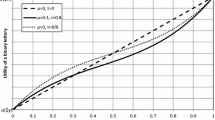Summary
The expected utility analysis of decision under risk needs information on the alternatives and on the decision maker's preferences which in many practical situations are difficult to obtain. This paper presents a procedure for choosing between multiattribute risky alternatives when the probabilities of outcomes are known, the utility function is general multilinear (i.e., can be decomposed into sums and products of univariate utility functions), and there is some partial information on univariate utilities (viz. increasingness) and arbitrary partial information on the scaling coefficients. Pairwise comparisons in the set of alternatives yield a subset which is efficient under the given partial information. Additive and multiplicative utility functions are special cases of the multilinear one. The paper gives particular attention to linear partial information (LPI) on coefficients, which is obtained by standard assessment procedures. The approach can be combined with dominance procedures which use other partial information as LPI on probabilities.
Zusammenfassung
Betrachtet werden Risikoentscheidungen bei mehreren Attributen. Für die Bestimmung des erwarteten Nutzens der Alternativen benötigt man Informationen über die Präferenzen des Entscheidungsträgers, die in konkreten Anwendungen häufig nur schwer zu beschaffen sind. Im folgenden Artikel wird ein Verfahren vorgestellt, mit dem man bereits Entscheidungen treffen kann, wenn die Risikonutzenfunktion allgemein multilinear ist (d. h. in Summen und Produkte von univariaten Nutzenfunktionen dekomponiert werden kann) und eine bestimmte unvollständige Information über die univariaten Nutzenfunktionen (nämlich monotones Wachstum) und beliebige unvollständige Information über die Skalenfaktoren vorliegt. Aus Paarvergleichen in der Menge der Alternativen erhält man eine bezüglich der gegebenen Information effiziente Teilmenge. —Additiv bzw. multiplikativ dekomponierte Nutzenfunktionen ergeben sich als Spezialfälle der multilinearen Form. Der Artikel behandelt eingehend die lineare partielle Information (LPI) über die Skalenfaktoren, die sich aus den üblichen Verfahren zur praktischen Ermittlung der Nutzenfunktion ergibt. Der Ansatz kann mit Dominanzverfahren kombiniert werden, die auf andere Arten unvollständiger Information (etwa auf LPI über die Wahrscheinlichkeiten) zurückgreifen.
Similar content being viewed by others
References
Bawa VS, Lindenberg EB, Rafsky LC (1979) An efficient algorithm to determinate stochastic dominance admissible sets. Bayesian Statistics 2, 25:609–622
Bazaraa MS, Shetty CM (1979) Nonlinear programming. John Wiley & Sons, New York
Bromage RC (1982) Partial information in linear multiattribute utility theory. Decision Science Consortium, Falls Church, VA
Ehemann K (1981) Entscheidungen bei partieller Information. Athenäum, Hain, Scriptor, Hanstein, Königstein/Ts
Farquhar PH (1975) A fractional hypercube decomposition theorem for multiattribute utility functions. Oper Res 23:941–967
Fishburn PC (1964) Decision and value theory. John Wiley, New York
Fishburn PC (1965) Analysis of decisions with incomplete knowledge of probabilities. Oper Res 13:217–232
Fishburn PC (1973) Bernoullian utilities for multiple-factor situations. In: Cochrane JL, Zeleny M (eds) Multiple criteria decision making. University of South Carolina Press, Columbia, SC
Hadar J, Russell WR (1969) Rules for ordering uncertain prospects. Am Econ Rev 59:25–34
Hannon EL (1981) Obtaining nondominated priority vectors for multiple objective decision making problems with different combinations of cardinal and ordinal information. IEEE Trans Syst Man Cybern 11:538–543
Hanoch G, Levy H (1969) The efficiency analysis of choices involving risk. Rev Econ Stud 39:335–346
Hazen GB (1986) Partial information, dominance, and potential optimality in multiattribute utility theory. Oper Res 34:296–310
Jacquet-Lagrèze E, Siskos J (1982) Assessing a set of additive utility functions for multicriteria decision making, the UTA method. Eur J Oper Res 10:151–164
Keeney RL, Raiffa H (1976) Decisions with multiple objectives: preferences and value tradeoffs. John Wiley, New York
Keppe H-J, Weber M (1990) Stochastic dominance with incomplete information on probabilities. Eur J Oper Res 43:350–355
Kirkwood CW, Sarin RK (1985) Ranking with partial information: a method and an application. Oper Res 33:38–48
Kofler E, Menges G (1976) Entscheidungen bei unvollkommener Information. Springer, Berlin Heidelberg New York
Kofler E, Kmietowicz ZW, Pearman AD (1984) Decision making with linear partial information (L.P.I.). J Oper Res Soc 35:1079–1090
Köksalan MM (1989) Identifying and ranking a most preferred subset of alternatives in the presence of multiple criteria. Nav Res Logist 36:359–372
Korhonen P, Wallenius P, Zionts S (1984) Solving the discrete multiple criteria problem using convex cones. Manag Sci 30:1336–1345
Mathies TH, Rubin DS (1980) A survey and comparison of methods for finding all vertices of convex polyhedral sets. Math Oper Res 5:167–185
Mosler KC (1984) Stochastic dominance decision rules when the attributes are utility independent. Manage Sci 30:1311–1322
Mosler KC (1987) Multiattribute risk posture and decomposition of utilities. Discussion paper in statistics and quantitative economics No. 29. Universität der Bundeswehr Hamburg
Pearman AD, Kmietowicz ZW (1986) Stochastic dominance with linear partial information. Eur J Oper Res 23:57–63
Richard SF (1975) Multivariate risk aversion, utility independence,and separable utility functions. Manage Sci 22:12–21
Sage AP, White III CC (1984) Ariadne: a knowledge-based interactive system for planning and decision support. IEEE Trans Syst Man Cybern 4:35–47
Scarsini M (1988) Dominance conditions for multivariate utility functions. Manag Sci 34:454–460
Schoemaker PJH, Waid CC (1982) An experimental comparison of different approaches to determining weights in additive utility models. Manag Sci 28:182–196
Vickson RG (1977) Stochastic orderings from partially known utility functions. Bell Syst Technical J 2:244–252
Weber M (1987) Decision making with incomplete information. Eur J Oper Res 28:44–57
White III CC, Sage AP (1980) Multiple objective optimization-based approach to choicemaking. IEEE Trans Syst Man Cybern 10:315–326
Author information
Authors and Affiliations
Rights and permissions
About this article
Cite this article
Mosler, K. Multiattribute utility functions, partial information on coefficients, and efficient choice. OR Spektrum 13, 87–94 (1991). https://doi.org/10.1007/BF01719932
Received:
Accepted:
Published:
Issue Date:
DOI: https://doi.org/10.1007/BF01719932
Keywords
- Decision theory
- multiattribute choice
- stochastic dominance
- multilinear utility decomposition
- linear partial information




